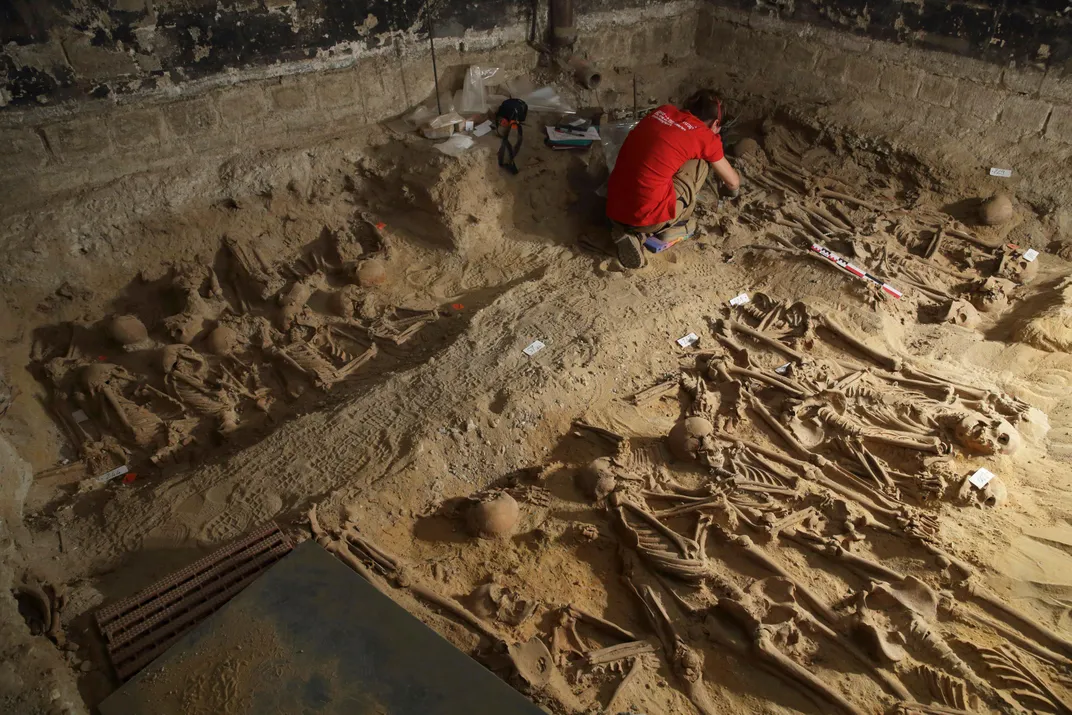Plague Was Infecting Humans 3,300 Years Earlier Than Thought
DNA from Bronze Age victims helped pinpoint mutations that allowed the disease to go from localized illness to deadly pandemic
/https://tf-cmsv2-smithsonianmag-media.s3.amazonaws.com/filer/83/f1/83f16eac-bc06-4289-a9ba-b4c081a4c682/plague-skull.jpg)
The plague is one of history's most notorious killers—but it appears we've underestimated its terrible toll. DNA evidence suggests that plague-causing bacteria infected humans thousands of years earlier than previously believed and likely caused countless more deaths.
The genome study also reveals much about how the plague evolved from a relatively benign bacterium to an efficient killer that would wreak havoc across the globe.
Three devastating outbreaks have previously been linked to the plague by historical records and DNA studies. The First Pandemic began with the Plague of Justinian around A.D. 541 and killed up to 100 million people. The Second Pandemic included the 14th-century Black Death, responsible for killing some 30 to 50 percent of Europeans. And the Third Pandemic, which arose in China during the 1850s, lasted until the mid-20th century.
But when researchers sequenced DNA from the teeth of Bronze Age humans from Eurasia, they found genetic signs of the bacterium that causes plague, Yersinia pestis, in 7 out of 101 individuals tested. That means the plague was infecting people at least 4,800 years ago—some 3,300 years earlier than is known from the historical record.
Notably, the team also found that during those early centuries, the bacterium hadn't yet acquired tiny but key genetic mutations that gave rise to legendary scourges.
“The plague bacterium is very similar to its ancestor, the bacterium Y. pseudotuberculosis,” explains co-author Simon Rasmussen, of the Technical University of Denmark. “But that ancestor isn't so harmful. If you eat it, you'll feel bad, but you don't die from it. So how could a bacterium that's harmful but not deadly evolve into one of the most deadly that's ever existed for humans?”
Historic plague pandemics like the Black Death were mostly spread when humans shared close quarters with rats carrying infected fleas. When a flea drinks an infected animal's blood, the plague bacteria enter the flea's gut, where they not only grow but also block the gut so that the flea becomes extremely hungry. This encourages the flea to reach out and bite more hosts—and thus deliver more plague bacteria.
Plague victims as far back as the Iron Age were infected with Y. pestis bacteria that have the gene Yersinia murine toxin, or ymt, which is required for the pest to survive within a flea's gut. But the new gene analysis, appearing this week in Cell, shows that Bronze Age bacteria lacked this mutation, helping to pinpoint a vital evolutionary moment.
“Here we're able to directly identify when this happened, when this bacteria went from not being able to live in fleas to this very important part of its lifestyle. That tells us a lot about how a pathogenic bacteria evolves into becoming even more dangerous,” Rasmussen says.

The more ancient bacteria were also missing a mutation that enabled the infection to spread from the lungs to other tissues like the lymph nodes, Rasmussen notes.
“So at that time we have a kind of intermediate plague,” he says. “These Bronze Age strains couldn't cause bubonic plague, but they caused septicemic plague in the blood and pneumonic plague in the lungs, which you can transmit through the air whenever you sneeze or cough.”
Earlier this year, Wyndham Lathem, a microbiologist at Northwestern University Feinberg School of Medicine, and his colleagues published a study showing how not-so-deadly bacteria might have become the plague. They used mouse models of Y. pestis infection to show that it was possible the bacterium initially caused the respiratory form of the disease before it acquired the mutations that created bubonic plague and transmission by fleas.
“So what I got excited about reading this study is that we now have evidence that supports that hypothesis,” says Lathem. “If these Bronze Age strains can't be transmitted by fleas, but yet are infecting humans, what's the likely disease that they would be getting? I think it's very likely it would be pneumonic plague.”
That's not to say the Bronze Age version of the disease was less dangerous, Rasmussen adds. “When you get pneumonic plague, it's almost 100 percent fatal. Even today you have to treated within like 24 hours or it's just goodbye. Back then, of course, it was just as deadly and people didn't even know that they had caught a disease or where it came from. It must have been really terrifying”
Still, airborne transmission was likely unable to produce the kind of mass plagues that history later witnessed, perhaps killing on a scale of villages rather than across continents, suggests David Wagner of Northern Arizona University, who recently worked on sequencing the Y. pestis genome from the sixth-century Plague of Justinian.
“When I think of plague, I think of it as a disease of rodents and fleas,” he says. “But what did the fact that it didn't have flea-borne transmission mean for human disease events? It probably meant that it was less common, and I think it says something about the importance of flea transmission during the great pandemics."

Rasmussen and his colleagues also used their data to trace the plague to its genetic roots. According to their calculations, the common ancestor of all known Y. pestis strains was part of human history 5,783 years ago.
“That age really coincides with the time when people start living in cities," Rasmussen notes. "It's a kind of melting pot environment with lots of humans and animals in houses, and very poor hygiene. People have been thinking for a long time that this environment might have kind of helped to kick off the evolution of many of these very infectious human diseases.”
Further tracing the timeline of plague evolution may reveal whether the disease was involved in historic human migrations. For instance, a recent population genomics study of Bronze Age Eurasians by many of these same authors revealed a dynamic period of large-scale migrations that helped shape the current demographics in both Europe and Asia.
“Did an influx of people maybe bring disease in? Or did people flee from disease?" asks Rasmussen. "We of course can't prove anything about this at the moment, but we can put forth a theory that the plague was involved in these migrations.”
And because disease evolution is ongoing, this type of research is of interest beyond historic events, Lathem adds.
“We continue to learn that small genetic changes can have huge impact on human health and disease,” he says. “We have here a bacteria that was able to infect humans much earlier than we thought, but it was missing a couple of key factors that might have restricted its spread to smaller populations. But then it just picks up one gene and a couple of mutations and suddenly we've gone from small local outbreaks to global pandemic infections.”
For Lathem, that's the really important takeaway message: "It may be that some disease, Ebola for example, could acquire a new gene or piece of DNA and then be spread through the air rather than just through bodily fluids. In that kind of example, we'd then have a much bigger problem on our hands.”